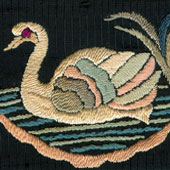There were basically two ways in which the border was worn. One was as an add-on to an existing plain or jacquard sari and the other was an embroidered border as an extension of an embroidered “gara” sari. In this article the author has focussed on the add-on embroidered border that was sewn on to a plain sari. The embroidered border as an extension of the embroidered sari is a vast and comprehensive subject. This border flows from the main content of the embroidered sari and therefore often has a repeat of the motifs and icons in the main body of the sari fabric. The author’s study of the “gara” is limited and therefore defines the scope and limitation of this article.
The add-on border served two purposes. It added a decorative element to an otherwise plain garment. It also held the light fabric down with its own weight and thereby prevented the sari from riding up the wearer’s leg. This was a genuine concern as some Chinese unembroidered plain silks and French chiffons were extremely light fabrics and could cause embarrassment to the wearer if worn without being weighed down by a border. One must recall that these were (Victorian) times when legs and even feet were not exposed in public. And although the sari as a garment was adopted by the Parsis in India, the Indian Parsis did not expose their midriffs in the manner of their other Indian counterparts. This was so well into the middle of the first quarter of the 20th century. In fact, I recall my grandmother always wearing a long blouse under her sari; long ruffled sleeves that covered her wrists, the ends of the blouse weighed down by pieces of lead so it would not ride up above the sari waist band. In many ways, the borders held the sari down and in place, a requirement that fulfilled the principles of modesty of that time. Curiously, therefore, the embroidered border had a functional purpose in the plain sari and not just a superficial or symbolic ornamental one.



